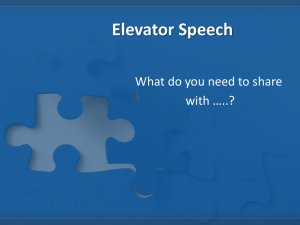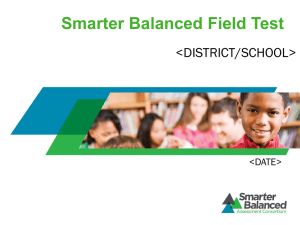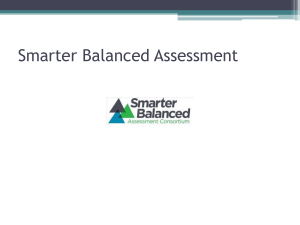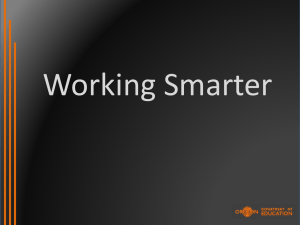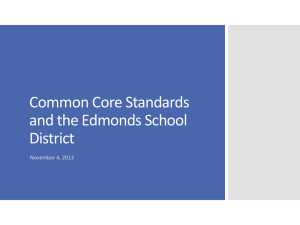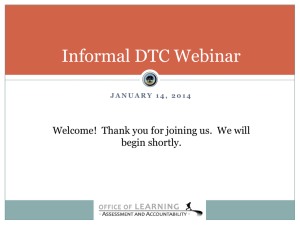Updates on School Accountability convention presentation
advertisement
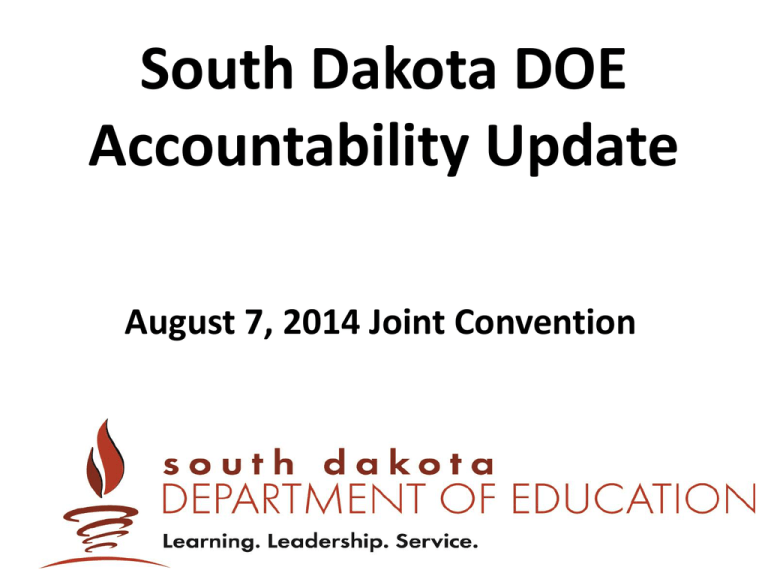
South Dakota DOE Accountability Update August 7, 2014 Joint Convention 2013-14 School Report Cards Schedule: • Pre-appeal window closed July 18; • Changes will be made and validated next week; • Embargoed version released for district accountability teams to look at Friday, August 15; • Public Report Cards released Tuesday, August 19; • Formal Appeals due back to SD DOE by September 5, 2014 What data do I need to report home? Smarter Balanced Schools • No ELA or Math data to send home • Science reports for students who took the Science Assessment must go home (print from South Dakota Assessment Portal or from Infinite Campus) DSTEP Schools • ELA and Math reports need to go home • Science reports for students who took the Science Assessment must go home • Print from South Dakota Assessment Portal or from Infinite Campus Public Report Cards must be shared with your stakeholders and the public as in prior years. Key notes for the 2013-14 Report Cards Logging Into SD-STARS • Website: https://doestars.sd.gov • User Name: Email Address • Password: Set by you You now have the ability to change between years in the Report Card You can access Video Tutorials to walk you through the report card in the training center • Calculation Guide • Video Tutorials on Navigating To the Through the Accountability Report Cards in SD-STARS Questions about how something was calculated? Look for more information in the Calculation Guide Changes for 2013-14 • Because there will be no School Performance Index scores for 2013-14, current classifications remain in place. Changes for 2013-14 • No participation rates for both Smarter Balanced and Dakota STEP schools will be reported in SDSTARS or the Accountability Report Cards • The Department will report participation rates separately later in Fall 2014 Changes for 2013-14 • Those schools who took the Smarter Balanced assessment in 2013-14 will not have any student achievement results. • Those schools who took the paper/pencil Dakota STEP will have student achievement results. Everyone who had tested students in grades 5,8,11 should see Science Results in the All Assessed Report Accountability Moving Forward Waiver Extension Process • Began collecting feedback immediately after roll out of new accountability calculations in Fall 2012 • US DoE monitoring in October 2012, August 2013 • Presented proposed changes in November and December 2013 to: – – – – • • • • • Board of Education Secretary’s Advisory Council Accountability Work Group Committee of Practitioners US DoE feedback received in February and March 2014 Sent out for Public Comment May 2014 Submitted May 2014 Approved July 2014 for the 2014-15 academic year Directions for 2015-16 and beyond to come this winter Changes for the 2014-15 school year • Attendance: based on the percentage of students meeting state attendance goal (94%) • Educator effectiveness and school climate officially removed from SPI, still areas of critical focus • Updates to Focus and Priority work to reflect current practice • Updated information about working with Other Title I schools • Updated information about data review and monitoring processes • Ability for Focus and Priority schools to remain in existing status if progress being made 2014-15 Assessment REQUIRED ASSESSMENT: • All Public Schools will take the Smarter Balanced Assessment in ELA and Math. • Alternate Assessment students will take the NCSC. • Science will still be the DSTEP-Science in some format. SD DOE is working through the contract process now. • 2014-15 is a NAEP year. • ACCESS assessment for English Learners still paper and pencil, online field test happening. • NO Additional Writing Assessment will be given. 2014-15 Assessment OPTIONAL ASSESSMENT: • Schools can still use the South Dakota Assessment Portal (SDAP) to give classroom, End of Course (with a waiver), district secure, and benchmark assessments. • Many schools will use SDAP to create common assessments for SLOs. • National Career Readiness Certificate (NCRC) is available for any public high school at one grade level. • The Accuplacer exam can be used to address remediation needs before entering college. • Smarter Balanced Interim Assessments will be available this winter • Smarter Balanced Digital Library resources forthcoming Smarter Balanced Field Test in South Dakota by the numbers • 150/151 Public school systems • 20/20 BIE/Tribal systems • 36/53 Non-public systems • • • • • 70,560 student took tests 279,137 tests started 278,164 tests submitted 1,200+ district personnel involved 4 SD DOE Staff with tech support from BIT Were the schools ready? Survey says…. Themes that emerged from the survey feedback: • If students and staff did practice tests, the field test went smoother • Tech staff must be involved • Shift to on-line testing created confusion and concerns with accommodations • Text-to-speech and sound the biggest problem across all respondents. • Wide variance in district level communication procedures A comment from the field • Overall, for the field test, it went well. We all knew the test would be challenging. As a parent, my own son came home and shared that he was very glad that the writing part could be done with a keyboard. He state, “I don’t like to write, but if I could do it on a computer,…that makes it a lot easier! I wrote a lot for the Smarter Balanced test!” Coming Attractions • Smarter Balanced is more than a single test! By late fall, public schools will have access to resources for formative (Digital Library) and interim assessments (comprehensive and content blocks) . Next Steps • AIR (American Institutes for Research) will be the vendor to deliver Smarter Balanced for South Dakota • October 6- 17, 2014 Online Panel for Achievement Setting – To register, go to SmarterBalanced.org/OnlinePanel Next Steps: Setting Achievement Levels A Two Part Process • Part 1 October 6- 17, 2014 Online Panel for Achievement Setting – To register, go to SmarterBalanced.org/OnlinePanel – This process is open to educators, administrators, parents, community members – 6 hours of time to complete Next Steps: Setting Achievement Levels A Two Part Process • Part 2 In- person Panels • October 13 – 20 – Educators from across the participating states – South Dakota has an equal voice in the panels In early November, all participating states will vote on the achievement levels for each grade and each content. Scores English Language Arts Mathematics Total Scale Score and Achievement Level + information on: Total Scale Score and Achievement Level + information on: Reading Concepts & Procedures Writing Speaking/Listening Research Problem Solving & Modeling/Data Analysis Communicating Reasoning Statewide Fall Assessment Workshops • • • • • Sept. 15 – Outdoor Campus, Rapid City Sept. 16 – Kings Inn, Pierre Sept. 17 – Ramkota, Aberdeen Sept. 18 – Lake Area Tech, Watertown Sept. 19 – Southeast Tech, Sioux Falls Audience: District level administrators, assessment and tech staff Time: 8 – 4 Focus: Overview of state assessment system and next steps. Mapping the Future Fall 2014 and Beyond • More targeted professional development to specific groups, both in-person and web-based • Direct meetings with tech coordinators • Manuals and training materials must be teacherfriendly • Small districts – need more staff to support the district test coordinator (typically the high school counselor) • Communication on blueprints, achievement standards, and claims – reporting results Future Accountability Changes 2015-16 Results and beyond • Multiple years achievement data to be included (building to 3) • Multiple ways to show College Readiness • Career Readiness as an optional measure • Student Growth measure for Elementary and Middle Schools Growth Model Work Group Spring 2013 –convened key education professionals, REL helped facilitate Defined purpose and non-negotiables: • Fair to large and small schools • Takes growth of ALL students into account, not just “bubble kids” or non-proficient students • Ability to explain to parents and those outside the educational field • Not just another measure of proficiency Purpose of Growth Model • Measure for School Accountability models (SPI) at Elementary and Middle School levels • Give all schools an additional opportunity to show gains being made as opposed to only using a proficiency based measure • NOT created for use as a mandated growth model for teacher effectiveness models Process • REL compiled research and examples of most common models • Eliminated models that violated nonnegotiables • Talked with peers and looked at examples of other models in more depth • Looked at SD data and came up with final recommendation Final Models Investigated • Student Growth Percentiles and Residual Gains Models – Easier to understand and explain – Performance is compared to expected gains giving you a sense of whether adequate growth is made – Considers prior performance to determine adequate growth Process Used to Compare the Models • Fit both types of models using student assessment data from 2011-12 and 2012-13. • Looked at 3rd-8th grade mathematics and reading. • Examined the distribution of growth scores for students and schools. • Examined results for small (10-20) and large schools (greater than 500). Final Recommendation • Student Growth percentiles better model SD data. • Residual gains forces a linear model. SGP allows for growth to be non-linear. • SGP has been successfully implemented in multiple states. • Benefit to comparing students to students that are like them across the state, instead of to all students in their grade. Student Growth Percentiles • What are SGPs? – Indicators of student growth: test scores compared to scores of students with similar score histories. • What can SGPs tell us about student growth? – How much a student grew, relative to students with a similar score history (academic peers). A student with an SGP of 65 performed better than 65% of his/her academic peers. • Which states are using SGPs? – Several have adopted as a measure of growth including Colorado, Arizona, and Utah. – Allows SD to leverage the programming, communications, and lessons learned. Source: Castellano & Ho (2012) Determining points in the accountability system (beginning with 2016 results) • Continuous model to parallel the way points are assigned for achievement (0-40 points). – Half the points are assigned based on the growth for the lowest 25% of students in your district/ school; – Half the points are assigned based on the growth for ALL students (MGP) Next Steps • • • • • Develop a template for reporting Create communication plan and build awareness Submit to US DoE for ESEA Flexibility approval Release first results after SY 15-16 Continue to monitor system Contacts • Questions about SPI – Abby Javurek-Humig, abby.javurek-humig@state.sd.us • DOE Accountability Data Contact – – – – – Judy Merriman, judy.merriman@state.sd.us Randy Hanson, randy.hanson@state.sd.us Teri Jung, teri.jung@state.sd.us Tom Morth, tom.morth@state.sd.us Jennifer Rattling Leaf, jennifer.rattlingleaf@state.sd.us • SD-STARS Project Managers – Marcus Bevier, marcus.bevier@state.sd.us – Sara Kock, sara.kock@state.sd.us Contacts • Questions about Growth – Abby Javurek-Humig, abby.javurek-humig@state.sd.us • DOE Assessment Contacts – Jan Martin, jan.martin@state.sd.us (Smarter Balanced, all general questions) – Matt Gill, matthew.gill@state.sd.us (South Dakota Assessment Portal and Digital Library) – Mike Rickert, michael.rickert@state.sd.us (End of Course Exams) – Alan Haarstad, alan.haarstad@state.sd.us (NAEP) – Ben Morrison, ben.morrison@state.sd.us (NCSC Alternate Assessment) – Yutzil Rodriguez, yutzil.rodriguez@state.sd.us (ACCESS for English Language Learners)
